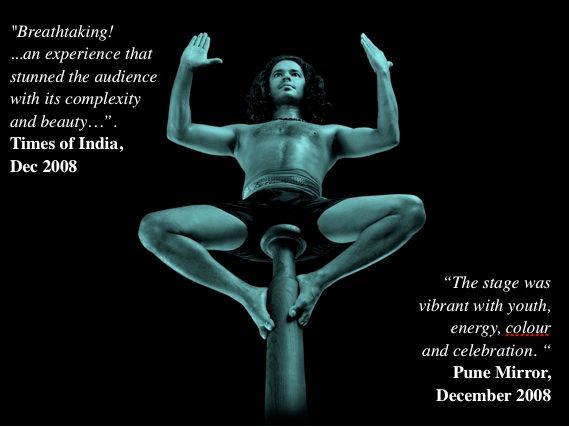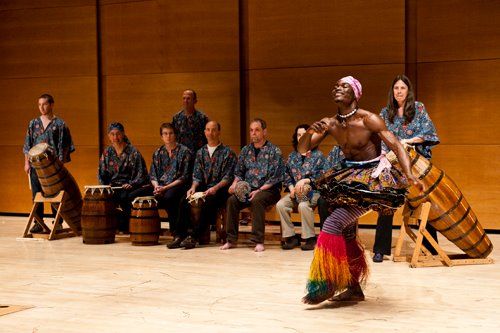environment India Politics: climate refugees denialists glacial melt irrigation mountains
by Warren
leave a comment
Meta
SiteMeter
Brighter Planet
Year 4, Month 5, Day 27: River Deep, Mountain High
The LA Times, on Mount Everest. So to speak.
A warming climate is melting the glaciers of Mount Everest, shrinking the frozen cloak of Earth’s highest peak by 13% in the last 50 years, researchers have found.
Rocks and natural debris previously covered by snow are appearing now as the snow line has retreated 590 feet, according to Sudeep Thakuri, a University of Milan scientist who led the research.
The pessimistic view of Earth’s tallest peak was presented during a meeting Tuesday of the American Geophysical Union in Cancun, Mexico.
Researchers said they believe the observed changes could be due to human-generated greenhouse gases altering global climate, although their research has not established a firm connection.
The team reconstructed the glacial history of the area using satellite imagery and topographic maps of Everest and the surrounding 713-square-mile Sagarmatha National Park. Their statistical analysis shows that the majority of the glaciers in the national park are retreating at an increasing rate, Thakuri said.
Why? Because it’s not there. May 15:
Once we set aside the iconic importance of a shrinking Mount Everest, the really ominous facts about disappearing ice caps in the Himalayas are the numbers of people whose lives depend on them. Whether it’s for irrigation, hydroelectric generation, or clean drinking water, this steady flow from the world’s tallest mountains is crucial for the existence of almost a seventh of the world’s population. If we subtract that water from the picture, what’s left are hundreds of millions of climate refugees, desperate, landless, hungry, thirsty.
But these people may be more fortunate than many in the developed world who rely on elaborate infrastructure for their food and water. Why? Because they can simply look up and see the daily changes on these peaks, they’re not tempted by magical thinking and ideologically-motivated denialism, like those whose air-conditioned lives have allowed them to ignore the climate crisis until it’s already upon them.
Warren Senders
environment India Politics: agriculture corporate irresponsibility sustainability
by Warren
leave a comment
Meta
SiteMeter
Brighter Planet
Year 4, Month 5, Day 26: Directly From My Heart To You
India West talks about the economic implications of climate change:
Sustainable development that mitigates the impact of climate change for India’s poor can only be achieved by the devolution of the Indian government, stated prominent social activist Sunita Narain at a March 27 lecture at Arizona State University.
“Getting the model of development right so that everyone has access to health care, water and energy supplies is only achievable when the government is de-centralized,” Narain told India-West in an interview after the lecture, which was organized by ASU’s Global Institute of Sustainability.The director general of the New Delhi-based Centre for Science and Environment, Narain has received numerous accolades for her work, including the Padma Shri – India’s highest honor – in 2005. In 2007, Narain was named by Time magazine as one of India’s 15 most influential people. Foreign Policy magazine has thrice named Narain one of the world’s best intellectuals.
“Climate change is already hurting the world’s most poor and vulnerable,” stated Narain, explaining that rainwater – a major resource for India’s largely agrarian population – has been inconsistent, with more rainfall, but for a fewer number of days.
“Farmers are very desperate today. This is their livelihood; it is the only thing they know. And we can send them to cities to get jobs, but the urban sector doesn’t have the ability to absorb all those people,” stated Narain.
A smallpox-infested atmospheric blanket offered to the world’s poor. May 14:
As rising levels of carbon dioxide push the greenhouse effect into overdrive, agriculture all over the world is going to be affected; harvests will shrink, crops will come under attack from invasive parasites and diseases, and inevitably subsistence farmers and small landholders in the world’s poorest countries are going to suffer. In comparison to rich and developed countries, Bangladesh’s carbon footprint is statistically insignificant, yet its citizens are facing imminent displacement from their lands, lives and hopes due to rising sea levels — and this is just one example of a worldwide phenomenon. The cruel irony of global warming is that while the greenhouse emissions triggering planetary warming are produced by the richest and most privileged among us, those who are already economically and politically disenfranchised will reap the whirlwind.
History notes many cases of intentional genocide in the service of colonialism and economic expansion. Climate change’s impact on the world’s poorest people wasn’t planned, but that’s no consolation. It falls to the developed world to act responsibly on the climate crisis, or to shoulder the blame for a catastrophe with both environmental and humanitarian dimensions.
Warren Senders
environment India music: benefit concert
by Warren
2 comments
Meta
SiteMeter
Brighter Planet
Dancing For The Planet

Navarasa Dance Theater
Nani Agbeli & The Agbekor Society
Zoé Dance Company
Friday, June 21 — 7:00 pm — Boston
On Friday, June 21, three dance companies representing diverse movement traditions will join together to draw attention to the global climate crisis. Featured artists are the Zoé Dance Company, the Navarasa Dance Theater, and Nani Agbeli & The Agbekor Society. The music begins at 7:00 pm, at Emmanuel Church, 15 Newbury Street, Boston, MA. Tickets are $20; $15 students/seniors. All proceeds will go to 350ma, the Massachusetts chapter of the environmental organization www.350.org. For information, please call 781-396-0734, visit “Dancing For The Planet” on Facebook, or send us an email.
“Dancing For The Planet” is the seventh concert in the “Playing For The Planet” series, conceived as a way for creative performers to contribute to the urgent struggle against global warming. Because the climate problem recognizes no national boundaries, the artists represent styles from three different parts of the globe. Their choice of beneficiary, 350MA.org, is focused on building global consensus on reduction of atmospheric CO2 levels — action which climatologists agree is necessary to avoid catastrophic outcomes. It’ll be an evening of brilliant dance and movement — for the central cause of our century.
Purchase tickets online from CCNOW:
Regular admission: $20
Student/Senior Admission: $15
Advance Ticket Orders Are Accepted Until 3 pm on June 21. Orders received after Tuesday, June 18 will be held at the door.
About the Artists
=======================================================

Navarasa Dance Theater was founded by renowned dancer/choreographer Dr. Aparna Sindhoor. Inspired by the eclectic performing arts traditions and boldly knitting together dance, singing, martial arts, and original music into seamless theatrical presentations, Navarasa’s multilayered, multilingual productions inspire, engage and entertain audiences around the world.

With original movement vocabulary created by choreographers Sindhoor and Anil Natyaveda along with theatrical narratives designed by S M Raju, Navarasa Dance Theater’s work is simultaneously specific and universal.



Navarasa Dance Theater has performed in North America, Asia and Europe and has been presented at various festivals and venues including the Bates Dance Festival, Lincoln Center (NYC), East West Players, LA and NJPAC, Jacob’s Pillow and Asian American Theater Festival, USA; Teesri Duniya Theater, Canada; Amol Palekhar’s Beyond Words Theatre Festival and Bahuroopi National Theatre Festival, India; and Franco Dragone’s INDIA show in Germany. With performing arts training schools in USA and India, Navarasa’s ongoing teaching programs include the “Dance for Everyone” project that offers scholarships and free dance training for underprivileged children and adults.

======================================================

Founded in 2002, Zoé Dance has presented works by Callie Chapman Korn, Ivan Korn, Emily Beattie and Meghan Ballog. Zoé Dance nurtures the art of dance, dance theatre and performance through accessible performance venues, educates the public and creates social awareness through themes explored in repertory, and has presented its work since 2002 in various venues and performance opportunities around Boston and internationally such as: World Music/CRASH Arts’ “Ten’s the Limit” (2005 and 2007), ArtBeat 2004 and 2009, “Virgin”, produced by the Dance Renewal Project, Harvard Square’s “May Fair” 2004, with the Choreographers Group 2004, Earth Dance’s Outdoor Performance Festival 2003, Corporación Cultural de Las Condes (Santiago, Chile) 2007, Boston Center for the Arts’ Mills Gallery as a featured artist of the Movement at the Mills residency.

Zoe has also presented its work at the Dance Complex, Cambridge Multicultural Arts Center, Tower Auditorium at Massachuestts College of Art, the Boston Common, Union Square Plaza, and Green Street Studios. Zoé Dance was awarded a project grant from the Somerville Arts Council (2010) and was a finalist for the Boston Dance Alliance’s Rehearsal and Retreat Fellowship (2009).

Callie Chapman Korn (artistic director): Callie holds a B.F.A. from the Boston Conservatory. With Zoé, Callie has presented her work in venues such as CrashArts‘ “Ten’s the Limit” at the ICA and Green Street Studios, Corporacion Cultural de Las Condes (Santiago, Chile), multiple self-produced concerts, festivals, part of the Dance Renewal Project’s “Virgin”, Dance Complex’s Shared Choreographers Concert. She currently dances for Prometheus Dance and has worked with artists such as: Nicola Hawkins, Karen Murphy and Emily Beattie. She has collaborated with video artists Greg Shea and Ken Kinna, composer Ivan Korn, and composers/musicians Pancho Molina and Billy Herron. Callie also helped develop the Dance Renewal Project and is currently the Marketing and Design Associate for the Boston Dance Alliance.

======================================================

Known for his energy, athleticism, and precision on stage, the charismatic Nani Kwashi Agbeli is a native of the Ewe from the Volta Region of Ghana, W. Africa. He received his drum and dance training from his father, Godwin K. Agbeli, who was the chairman of the National Folkloric Company at the Arts Council of Ghana. Nani performed with and led the cultural group Sankofa Root II in Ghana where they received many awards.

For nine years, he served as the lead drum and dance instructor at the Dagbe Cultural Center, a school that trains domestic and international students in Ghanaian traditional arts, and is now on the faculty of the Music Department at Tufts University, where he and directs the Kiniwe Ensemble and teaches an integrated curriculum in the traditional singing, drumming and dancing of Ghana.

Nani also teaches Ghanaian dance and drumming at Brandeis University and Mount Holyoke College, along with Berklee College of Music, the Edna Manley School in Jamaica, Bowling Green University, and the University of Virginia, among others. He currently lives in Boston, Massachusetts.

The Agbekor Drum & Dance Society began in 1979 as a project to study and perform repertory from Africa, primarily focusing on two separate repertoires: Ewe and Dagomba. The homeland of the Ewe people is along the Atlantic Coast of western Africa in the nation states of Ghana and Togo. The Dagomba homeland is in savanna grasslands several hundred miles to the north and the lands of their traditional kingdom, Dagbon, are entirely within the current borders of Ghana. In Ewe drumming, each instrument has a specific rhythm that it repeats over and over. Riding on this musical wave, so to speak, the lead drum sends musical signals that cue dancers when to do their different variations. In Dagomba dance-drumming, four different drum parts intertwine their variations. In both Ewe and Dagomba traditions, each item of repertory has its unique purpose, meaning, history, and performance personality.

In their frequent collaborations with Ghanaian master drummers, the Agbekor Society continues to renew its connection with its African sources. The Society has appeared in clubs, concerts, lecture-demonstrations and festivals throughout New England, and in collaborations with jazz and “world music” artists like Natraj, Antigravity and the Jazz Composers Alliance Orchestra.
======================================================
About www.350.org and the number 350:
Co-founded by environmentalist and author Bill McKibben, 350.org is the hub of a worldwide network of over two hundred environmental organizations, all with a common target: persuading the world’s countries to unite in an effort to reduce global levels of atmospheric carbon dioxide to 350 parts per million or less. Climatologist Dr. James Hansen says, “If humanity wishes to preserve a planet similar to that on which civilization developed and to which life on Earth is adapted, paleoclimate evidence and ongoing climate change suggest that CO2 will need to be reduced to at most 350 ppm.” (Dr. Hansen headed the NASA Institute for Space Studies in New York City, and is best known for his testimony on climate change to congressional committees in the 1980s that helped raise broad awareness of the global warming issue.) Activists involved in the 350 movement include Rajendra Pachauri (Chairman, Intergovernmental Panel on Climate Change), Vandana Shiva (world-renowned environmental leader and thinker), Archbishop Desmond Tutu (1984 winner of the Nobel Peace Prize and a global activist on issues pertaining to democracy, freedom and human rights), Van Jones, Bianca Jagger, Dr. James Hansen, Barbara Kingsolver and many more.
======================================================
Warren Senders is the contact person for “Dancing For The Planet.” He is one of thousands of concerned global citizens hoping to trigger positive change through social action and the arts. He can be reached at warvij@verizon.net or by telephone at 781-396-0734.
======================================================
“Dancing For The Planet” will be pleased to supply photographs and promotional materials for each of the artists performing at this event.
atheism environment India Politics: apocalypse assholes Christians denialists idiots
by Warren
leave a comment
Meta
SiteMeter
Brighter Planet
Year 4, Month 5, Day 15: Shut Up He Explained
This study is red-hot, and most newspapers aren’t going to touch it. But the Central Michigan Morning Sun’s Eric Baerren takes it on. Good for him:
Will Christianity destroy humanity? Is it making the End Times a self-fulfilling prophesy?
That’s only a half-fair assessment. To be truthful, religious beliefs don’t shape people’s general attitudes. They only reflect them. People who are prone to hating homosexuals, for instance, are prone to find reason in their religious tomes for doing it.
A study a few years back found that 76 percent of Republican voters believe that the end of times will come soon, kicking off one final epic conflict between God and the Antichrist. After God wins, he’ll clean up the planet and all of God’s believers get to spend eternity in paradise. Growing up, I attended a church attended by people who believe this. It was also in a part of the state notable for using religion as an excuse to rave on about the Apocalypse. And, let’s be clear about what this means: About 35 percent of the electorate is reliably Republican. If the poll is accurate, that means that the percentage of the American electorate who believes that the Biblical end is near is about 25 percent.
People who believe in the End Times are also statistically more prone to opposing things intended to curb climate change, which is the point of this. This shouldn’t surprise anyone. Conservatism is underpinned by a fear of change, and doing things to mitigate climate change means changing the way we do things. If you fear change, then you don’t want to do that, so naturally you find excuses not to like denying climate change or pretending that it’s all part of God’s plan.
Damn hard to get all this into 175 words. May 3:
While it’s true that religious beliefs don’t necessarily direct individual attitudes, it is indisputable that they can profoundly shape a society. Western civilization has been steeped for centuries in Christian theology; regardless of whether particular men and women believe in a Biblical apocalypse, there is no doubt that New Testament conceptions of time, progress and eschatology have steered our nominally secular society towards a self-fulfilling prophecy.
In every aspect of our culture — symphonies, movies, fairy tales — we observe “ways of ending” similar to those in the Book of Revelations: a dramatic final conflict, and a happy resolution. Study of other cultures shows that these models of closure are by no means universal.
End-times Christian opposition to significant action on climate change is only the visible face of a broader societal inability to imagine any other way to end our collective story. Believers see themselves living happily ever after; climate scientists, however, are much less sanguine about the coming centuries of life on Earth if we fail to address the unsettling facts of a runaway greenhouse effect.
Warren Senders
environment India: animals biodiversity climate refugees endangered species timescale
by Warren
leave a comment
Meta
SiteMeter
Brighter Planet
Year 4, Month 5, Day 8: The Song Is You
The Deccan Chronicle (India) notices climatogenic changes in bird migration patterns:
Kochi: It was a tradition in Kerala to wait for the vitthum kaikottum (seed and spade) call of the Indian cuckoo, which was the indication for farmers to begin sowing operations as the rains would not be long in coming. But that was then. Today, new species of birds have descended on the state, some never sighted here before. And climate change is said to be the reason. “The Aquila type of eagle, not historically reported in Kerala, is now commonly found.
These are commonly found in the very dry areas of Gujarat, Rajasthan and Punjab and have migrated to Kerala. The sparrow type wheatear or buntings noticed in the dry areas of central and north-western parts of the country have also been spotted across Kerala in the last few years,” says professor at the College of Forestry of Kerala Agriculture University, P.O. Nameer.
This is a new phenomenon and the presence of these birds is an indication that they are equally comfortable in the southern tip of the country as in northern parts which were their original homeland.
Ornithologist R. Sugathan says these are indications of global warming. “Birds do not migrate or come for fun. When a moist deciduous forest changes into deciduous, shedding its moist tag, a new set of birds and animals takes the place of the old. This is obvious in the changing pattern of migration of birds to Kerala. Some of them are now found going to places in neighbouring Karnataka and Tamil Nadu in search of food and breeding grounds.”
Anthropocentric thinking takes a hit. Sent April 26:
News coverage understandably tends to focus on the human face of climate change. Whether it’s an island nation anticipating its own disappearance beneath rising sea levels, or a farming culture grappling with increasingly extreme and unpredictable weather, there is no shortage of people confronting the grim realities of global warming.
But our own species isn’t the only one affected. At all levels of scale, from microscopic plankton to giant sequoias, the great web of Earthly life is being torn and disrupted by the consequences of industrial civilization’s two-century carbon binge. When hitherto unfamiliar bird species come visiting, it’s as much an indicator of climate change as melting glaciers or drought-cracked farmlands. While the arrival of the Aquila eagle or the Stonechat may be a brief boon for birdwatchers, it is an ominous sign of things to come. It’s not only humans who’re becoming climate refugees as the greenhouse effect intensifies.
Warren Senders
environment India Politics: corporate irresponsibility economics sustainability
by Warren
leave a comment
Meta
SiteMeter
Brighter Planet
Year 4, Month 4, Day 29: Truth Alone Prevails?
The Hindu (India) lets us know that Bharat Mata is stepping up to the plate:
Stating that India had launched itself to double the renewable energy capacity to 55000 MW by 2017, Prime Minister, Manmohan Singh on Wednseday expressed serious concern over the “painfully slow” progress of climate change talks, Prime Minister Manmohan Singh on Wednesday lamented that the goal of stabilising global temperatures at acceptable levels was nowhere in sight.
Delivering the inaugural address at the Fourth Clean Energy Ministerial, Dr. Singh said India had drawn up plans to double its renewable energy capacity to 55,000 MW by 2017 as part initiatives to promote renewable energy use. “It is proposed to double the renewable energy capacity in our country from 25000 MW in 2012 to 55000 MW by the year 2017. This would include exploiting non-conventional energy sources such as solar, wind power and energy from biomass,” he added.
The Prime Minister said rich nations, who were responsible for a bulk of greenhouse gas emissions, were best placed to provide workable solutions to mitigate climate change. “The industrialised nations have high per capita incomes, which gives them the highest capacity to bear the burden. They are technically most advanced, and to that extent best placed to provide workable solutions not only for themselves but for the whole world. Unfortunately, progress in these negotiations is painfully slow. The goal of stabilising global temperatures at acceptable levels is nowhere in sight,” he remarked.
“In India, we have set ourselves a national target of increasing the efficiency of energy use to bring about a 20 to 25 per cent reduction in the energy intensity of our GDP by 2020. The 12th Plan envisaged an expanded role for clean energy, including hydro, solar and wind power. The cost of solar energy for example has nearly halved over the last two years, though it remains higher than the cost of fossil fuel based electricity. If the cost imposed by carbon emissions is taken into account, then solar energy is more cost effective, but it is still more expensive,” added.
Long way to go, but at least headed in the right direction. Sent April 17:
Doubling the role of renewables in India’s energy economy is a hugely important step which can serve both as an inspiration to developing nations and a prod of conscience to the industrialized West. For too long American politicians, deep in the thrall of fossil fuel corporations, have used China and India as excuses for their own failure to act on climate change, arguably the gravest threat humanity has faced in its long and troubled history.
However, Prime Minister Singh is in error when he states that even when carbon emissions are taken into account, solar energy is “still more expensive” than fossil fuels. When we consider the costs of spill and leak mitigation and cleanup, of the complex and problematic public health impacts of these energy sources, and of the grave economic impacts of global climate change, it becomes clear that sustainable energy sources are by far the better deal.
Warren Senders
India Indian music music vocalists: genius
by Warren
leave a comment
Meta
SiteMeter
Brighter Planet
It really doesn’t…
…get any better than this.
A full-length performance of Kesarbai Kerkar singing Raga Malkauns.
Wow.
India Indian music music vocalists
by Warren
1 comment
Meta
SiteMeter
Brighter Planet
It’s Been A While Since I Posted…
…Mallikarjun Mansur’s ecstatic singing.
Here’s a late concert recording of two personal favorites, Raga Bihari (“Ye ho neend na aaye”) and Raga Paraj (“Ankhiyaa mori laagi”). I simply cannot get enough of the ceaseless flow of Mansur’s imagination.
India Indian music music vocalists: genius
by Warren
leave a comment
Meta
SiteMeter
Brighter Planet
It’s Agra Gharana Time!
Latafat Hussain Khan sings a drut khayal in Patdeepki:
India Indian music music vocalists: genius
by Warren
leave a comment
Meta
SiteMeter
Brighter Planet
Mogubai Kurdikar
One of the greatest singers of the 20th century. A disciple of Ustad Alladiya Khan, she represented the Jaipur-Atrauli gharana. Her daughter, Kishori Amonkar, is perhaps the best-known female khyal singer of today.
Raga Bageshri Bahar
